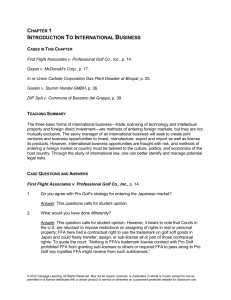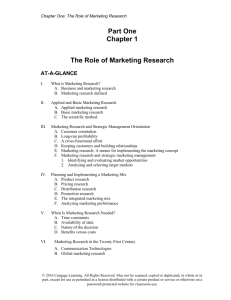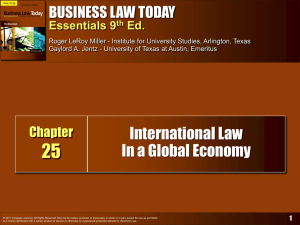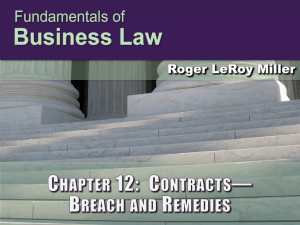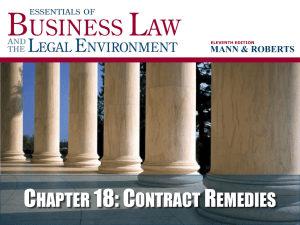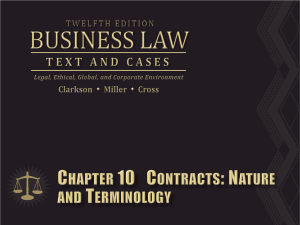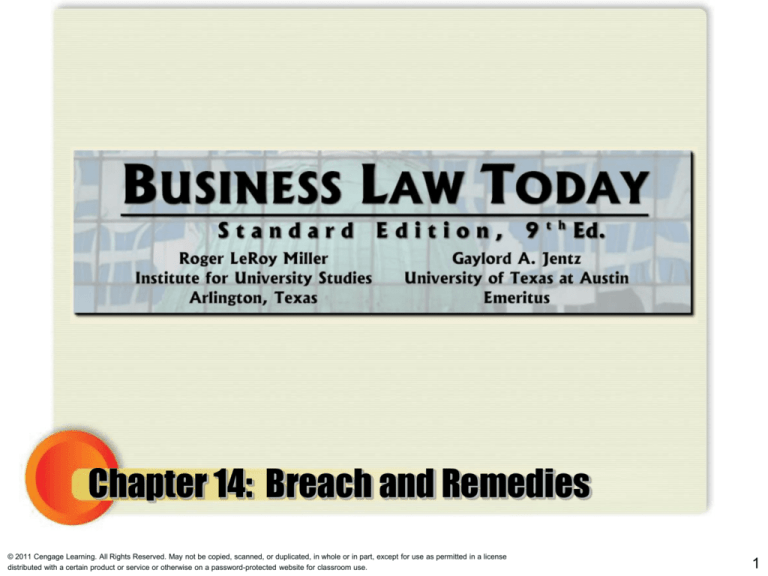
Chapter 14: Breach and Remedies
© 2011 Cengage Learning. All Rights Reserved. May not be copied, scanned, or duplicated, in whole or in part, except for use as permitted in a license
distributed with a certain product or service or otherwise on a password-protected website for classroom use.
1
Learning Objectives
• What is the difference between compensatory
and consequential damages? What are nominal
damages, and when do courts award them?
• What is the standard measure of compensatory
damages when a contract is breached? How are
damages computed differently in construction
contracts?
• Under what circumstances is the remedy of
rescission and restitution available?
• When do courts grant specific performance as a
remedy?
• What is a limitation-of-liability clause, and when
will courts enforce it?
© 2011 Cengage Learning. All Rights Reserved. May not be copied, scanned, or duplicated, in whole or in part, except for use as permitted in
a license distributed with a certain product or service or otherwise on a password-protected website for classroom use.
2
Damages
• Compensatory Damages:
– Compensates injured party (Plaintiff) who
must prove actual damages caused by
breach. Amount is calculated:
Generally: difference between Defendant’s
promised performance and actual.
Sale of Goods: difference between the contract
price and market.
Sale of Land: Usually specific performance (or
difference between contract price and FMV of
land.
Construction Contracts: Depends on the stage of
construction.
© 2011 Cengage Learning. All Rights Reserved. May not be copied, scanned, or duplicated, in whole or in part, except for use as permitted in
a license distributed with a certain product or service or otherwise on a password-protected website for classroom use.
3
Damages
• Consequential (Special) Damages
– Foreseeable damages that result from
breach of contract.
– Caused by other than breach of contract.
• Punitive (Exemplary) Damages.
– Deter wrongdoer; set example.
• Nominal Damages.
– Technical injury, no actual damages.
© 2011 Cengage Learning. All Rights Reserved. May not be copied, scanned, or duplicated, in whole or in part, except for use as permitted in
a license distributed with a certain product or service or otherwise on a password-protected website for classroom use.
4
Damages
• Mitigation of Damages.
– Injured party has a legal duty to mitigate
damages.
– Terminated employee has duty to take similar
jobs if available.
Case 14.1 Hanson v. Boeder.
Hanson reasonably mitigated his damages by
trying to find other farmland, which went to the
amount of recovery – not his failure to mitigate.
© 2011 Cengage Learning. All Rights Reserved. May not be copied, scanned, or duplicated, in whole or in part, except for use as permitted in
a license distributed with a certain product or service or otherwise on a password-protected website for classroom use.
5
Liquidated Damages vs. Penalties
• Liquidated: fixed, certain dollar amount
agreed to by parties, paid in the event of
breach. Clauses for liquidated damages
are enforceable.
• Penalties: designed to penalize a party.
Generally not enforceable.
© 2011 Cengage Learning. All Rights Reserved. May not be copied, scanned, or duplicated, in whole or in part, except for use as permitted in
a license distributed with a certain product or service or otherwise on a password-protected website for classroom use.
6
Damages Summary
© 2011 Cengage Learning. All Rights Reserved. May not be copied, scanned, or duplicated, in whole or in part, except for use as permitted in
a license distributed with a certain product or service or otherwise on a password-protected website for classroom use.
7
Equitable Remedies
• Rescission: cancel or undo a contract.
– Available for fraud, mistake, duress and failure of
consideration.
• Restitution: recapture the benefit conferred
on the defendant that has unjustly enriched
her.
– Parties must return goods, property or money.
© 2011 Cengage Learning. All Rights Reserved. May not be copied, scanned, or duplicated, in whole or in part, except for use as permitted in
a license distributed with a certain product or service or otherwise on a password-protected website for classroom use.
8
Equitable Remedies
• Specific Performance.
– Non-monetary relief only granted in cases where the
legal remedy is inadequate and the subject matter is
unique (e.g., land, or original art).
Case 14.2 Stainbrook v. Low.
Contract for sale of land was enforceable-even
after owner died-because buyer substantially
performed or was ready to perform.
• Contracts for Personal Services.
– Courts generally refuse to grant specific performance
due to notions of ‘involuntary servitude.’
© 2011 Cengage Learning. All Rights Reserved. May not be copied, scanned, or duplicated, in whole or in part, except for use as permitted in
a license distributed with a certain product or service or otherwise on a password-protected website for classroom use.
9
Equitable Remedies
• Reformation.
– Used when parties have imperfectly
expressed their agreement in writing.
– Court can rewrite the contract to reflect the
parties’ true intentions.
Case 14.3 Drake v. Hance.
Legal document can be reformed based on
parol evidence that shows a mutual mistake.
© 2011 Cengage Learning. All Rights Reserved. May not be copied, scanned, or duplicated, in whole or in part, except for use as permitted in
a license distributed with a certain product or service or otherwise on a password-protected website for classroom use.
10
Equitable Remedies
• Recovery based on Quasi-Contract.
Plaintiff must show:
– Benefit was conferred on the other party.
– Party conferring benefit expected to be paid.
– Party seeking recovery did not volunteer.
– Retaining benefit without payment would be
unjust enrichment.
© 2011 Cengage Learning. All Rights Reserved. May not be copied, scanned, or duplicated, in whole or in part, except for use as permitted in
a license distributed with a certain product or service or otherwise on a password-protected website for classroom use.
11
Contract Provisions Limiting Remedies
• UCC Allows Sales Contracts to Limit
Remedies.
• Enforceability of Limitation-of-Liability
Clauses.
– Generally, clause limiting damages for
intentional injury or fraud is NOT enforced.
– Limiting liability for negligence MAY be
enforced if parties have equal bargaining
power.
© 2011 Cengage Learning. All Rights Reserved. May not be copied, scanned, or duplicated, in whole or in part, except for use as permitted in
a license distributed with a certain product or service or otherwise on a password-protected website for classroom use.
12
Summary of Remedies Available
© 2011 Cengage Learning. All Rights Reserved. May not be copied, scanned, or duplicated, in whole or in part, except for use as permitted in
a license distributed with a certain product or service or otherwise on a password-protected website for classroom use.
13




